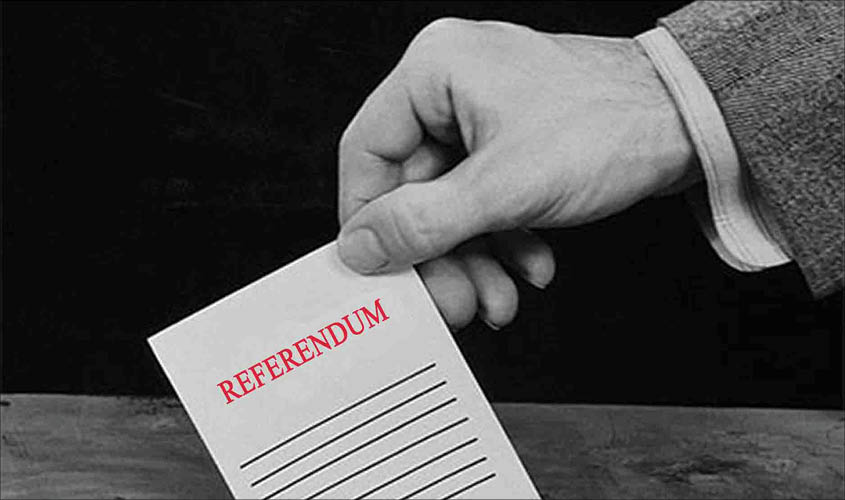Referendum results can often depend less on the true balance of public opinion and more on the side of the more energised supporters.
Here’s a paradox. If you have a group of people who want to decide on a course of action, you simply put it to the vote and the answer lies with the majority, even a majority of one. OK so far. But what if you have a nation of, say, 60 million, and you want the citizens to decide on a course of action which is going to have a major effect on their lives. You put the question to them and ask them to say “yes” or “no”, or perhaps “in” or “out”. Suppose now the result shows a majority of just one, in a turnout of 30 million. Do you go with that majority? Theoretically yes, but there would almost certainly be an outcry from the losers. The nation would be divided and tempers would fray, possibly leading to violence. Narrow majorities are sometimes referred to as the Tyranny of the Majority.
A referendum is a seductive political device. It allows leaders to claim a direct link with the popular will of the public. It also often encourages those who feel neglected and apathetic during normal elections, giving them a sense of empowerment. When used in the case of controversial issues, which is often the case, it provides political support when difficult downstream results emerge. “Well you voted for it!” A referendum sounds perfect.
But hold on. There are several stark downsides in using a referendum to resolve difficult issues. We live in the time of “fake news” and a referendum opens space for actors on either side to portray the choice between the status quo and the proposed change as a false one. In the age of social media it’s easy to seduce voters with false promises based on fantasies, if only voters rejected the choice recommended by the educated elite. The most vulnerable are those with poor education. This section of the electorate is susceptible to false information and unrealistic beliefs of what is possible, often stoked by opportunistic actors within the political system.
The supreme irony of a referendum is that while it typically asks voters to answer a simple “yes” or “no”, or “in” or “out”, it’s actually one of the most complicated forms of voting. The policy issues at stake are complex and the wording of the question on the ballot paper can sometimes be technical. In the UK, the Electoral Commission, an independent body which oversees elections and referendums, is required by law to carry out assessments of a referendum question to make sure it is clear, unambiguous and easy for voters to understand. This is to avoid the “have you stopped beating your wife” kind of question. In the Brexit vote in 2016, the Commission tested the question with about 1,000 participants, a lengthy and detailed process.
Confusion can sometimes be used to hijack a referendum by turning the question voters are actually asked into a question they would prefer to answer. Look at the alleged hijacking of the referendum in the Bahamas last year. The question was on the sensitive issue of gender equality in this conservative and Christian country. During the election period, rumours began to spread that by voting “yes”, in other words voting for gender equality and citizenship rights, would lead to same-sex marriage and LGBT rights, even though during the campaign this was emphatically ruled out. The result was that 79% voted against a humanitarian gender non-discrimination bill.
Despite their resemblance to democracy in action, referendum results can often depend less on the true balance of public opinion and more on the side of the more energised supporters. “Let the people decide” can lead to the domination of minority opinion, especially when there is a low turnout. For this reason, some countries require turnout thresholds to protect against minority views skewing results. While these may solve the problem, thresholds can be seen to be arbitrary and encourage non-participation for those who oppose a measure.
Only a few months ago the Republic of Macedonia held a referendum on the 27-year long dispute with its neighbour Greece over the name “Macedonia”. The solution agreed with the Greek government was to give the Macedonian people a referendum. Despite 94% being in favour, the referendum failed because the turnout of eligible voters was less than the required 50%. The government has said it will go ahead anyway, an action likely to stir instability in the country.
This newspaper has carried many excellent articles on UK’s Brexit referendum and the huge tensions in the country arising from the result. Despite a respectable turnout of 72.2%, there was only a small difference between those wishing to leave the European Union, 51.9% and those who wish to remain, 48.1%. Prime Minister Theresa May, who voted “remain”, has committed herself to respect the wishes of the people, but there is considerable unhappiness among the “Remainers”, accusing the Leave organisers of lies and dirty tricks. The Brexit referendum result, “Tyranny of the Majority”, has put British democracy under a huge strain and it will take many years to recover.
India has held only six referendums so far, and of these three were held during Independence. You have to go back to 1975 to find the last referendum, when Sikkim joined India. If there are any politicians on Raisina Hill contemplating a referendum, the advice is clear. Don’t!

